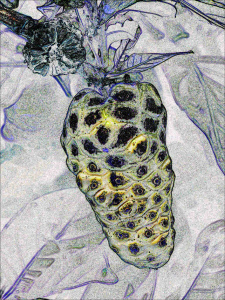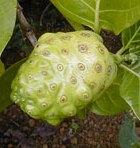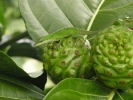Life Cycle and Reproduction
Noni have alternation of generations, a multicellular haploid and diploid stage. Noni flowers are "perfect", having both male and female organs within the same flower. Some people think that M. citrifolia and M. trimera are the female and male members of the species respectively, but that is incorrect.
 Noni’s
haploid stage is very short. It occurs during the
flowering stage in the anther and ovaries of the
flower. It is thought that one of the reasons that
the noni is so durable is due to self-pollination.
Many plants don’t do this because cross pollination
allows for genetic variation in the species, but noni
are, more or less, clones of one another due to this
self-pollination.
Noni’s
haploid stage is very short. It occurs during the
flowering stage in the anther and ovaries of the
flower. It is thought that one of the reasons that
the noni is so durable is due to self-pollination.
Many plants don’t do this because cross pollination
allows for genetic variation in the species, but noni
are, more or less, clones of one another due to this
self-pollination.
 Noni
flowers and fruits are produced throughout the year,
though it produces more fruit in the summer than in
the winter. In its natural habitat, the seeds of
the noni are dispersed by fruit bats, birds, and
other animals. Noni’s can live about 40 to 50
years, most likely longer.
Noni
flowers and fruits are produced throughout the year,
though it produces more fruit in the summer than in
the winter. In its natural habitat, the seeds of
the noni are dispersed by fruit bats, birds, and
other animals. Noni’s can live about 40 to 50
years, most likely longer.
Morinda citrifolia has one major tap root and many lateral roots. Noni doesn’t compete well with grasses due to its root system being primarily in the top soil. This plant also has a very aggressive root system that makes it extremely hard to kill once established in an environment.

